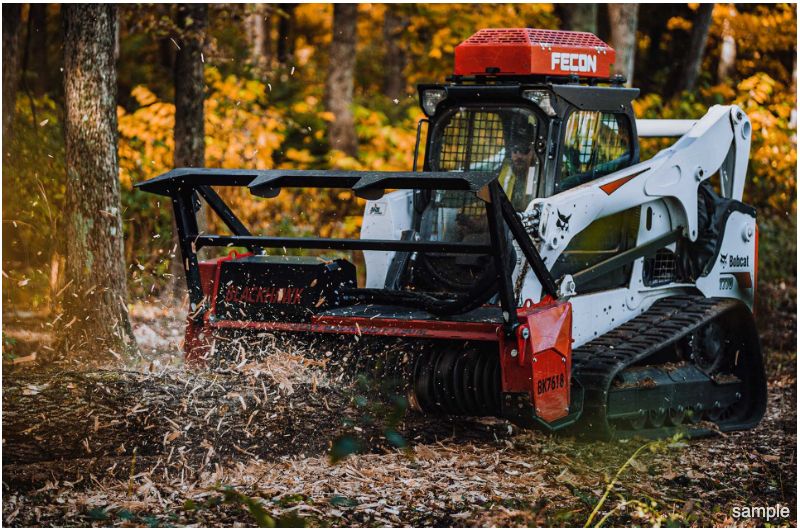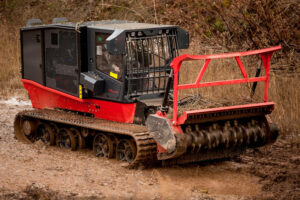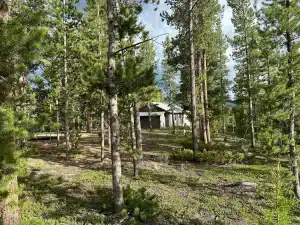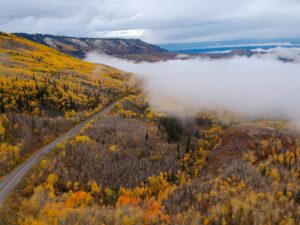The Highlights
- Forestry mulching is an approach to land clearing that uses specialized equipment to pulverize and chip small trees and vegetation or brush, creating a gentle mulch that is distributed back onto the forest floor.
- Forestry mulching returns valuable carbon and nitrogen back to the soil, enhancing the soil structure, reducing soil erosion, improving soil nutrients, and ultimately enhances the native ecosystem.
- Mulching can help to create an erosion barrier to prevent soil erosion. It offers superior erosion protection compared to traditional land clearing methods, especially on steep slopes. It’s a great way to maintain wildlife habitats, improve wildfire prevention, and keep soil structure intact while executing the land clearing that you need.
What is Forestry Mulching?
Forestry mulching is a land clearing method that involves the use of a specialized machine to shred vegetation and trees into small pieces. This process is environmentally friendly, as it does not leave any burn piles or heavy equipment marks, nor does it require large-scale hauling equipment.
The resulting material is often used as a nutrient-rich mulch or can be left in place to decompose and enrich the soil. In this guide, we will explore the benefits of forestry mulching and the steps involved in the process.
6 Benefits of Forestry Mulching
- Environmentally Friendly: Forestry mulching does not require the use of harsh chemicals or heavy machinery that can damage the environment as they smash around and through other vegetation or neighboring healthy trees. It is a sustainable land-clearing method that leaves behind a natural layer of mulched material.
- Cost-Effective: Forestry mulching is a cost-effective method for land clearing compared to traditional methods such as bulldozing or burning. It requires less labor and equipment, and the resulting mulch can be used on-site, saving transportation and disposal costs.
- Soil Improvement: The mulch left behind by forestry mulching is rich in nutrients and organic matter, carbon, and nitrogen from the unwanted vegetation, which improves soil fertility and promotes healthy plant growth.
- Erosion Control: The layer of mulch left behind after forestry mulching helps prevent erosion by protecting the soil from wind and water.
- Habitat Preservation: Forestry mulching is a gentle method of land clearing that minimizes damage to wildlife habitats and allows native plants and animals to thrive. It can also be an effective approach to taking care of invasive plant species on a large scale, to clear unwanted vegetation, and even in combating invasive insects that thrive on a particular plant.
- Fire Mitigation: Proactive mulching can be an effective tool for fire mitigation and land management, as it helps to reduce the amount of flammable vegetation and debris in an area. By removing dead or overgrown vegetation, forestry mulching can create firebreaks that can help slow the spread of wildfires. Additionally, the mulch left behind by the mulching process can help retain moisture in the soil, reducing the risk of fires starting from dry conditions. It is particularly effective in densely forested areas.
5 Steps Involved in Land Clearing with Forestry Mulching
- Site Preparation: Before the mulching process can begin, the site must be cleared of any debris or obstacles that could damage the mulching machine. This includes rocks, stumps, and other large items.
- Mulching: Once the site is prepared, the mulching machine is used to shred vegetation and trees into small pieces. The operator carefully maneuvers the machine through the area, avoiding any valuable trees or plants that should be preserved.
- Grading: After the mulching process is complete, the operator may use the machine to level and grade the area, creating a smooth surface for future use.
- Mulch Application: The resulting mulch can be used on-site to enrich the soil or to create a natural layer of mulch that helps prevent erosion and promote healthy plant growth.
- Cleanup: Any large debris or leftover vegetation like large rotten trees or rocks can be removed from the site, leaving behind a clean and clear area and mulch layer.
What Type of Machinery is Used for Forestry Mulching?
Forestry mulching is typically done using a specialized machine called a forestry mulcher, also known as a mulching head or a brush cutter. These machines are designed to grind up vegetation and small trees using a rotating drum equipped with cutting teeth.
Forestry mulching machines come in various sizes, from compact machines that can be used for residential land clearing projects, to large, heavy-duty machines that can clear acres of land in a single day. Forestry mulchers are typically mounted on a tracked or wheeled carrier, such as a skid steer or an excavator, which allows the operator to move the machine through the terrain and access hard-to-reach areas.
The forestry mulcher is powered by a hydraulic system that provides high torque to the cutting drum, allowing it to quickly shred vegetation and small trees into small pieces. Some forestry mulchers are also equipped with a mulch-dispensing chute that allows the operator to distribute the mulch evenly over the cleared area.
3 Machines Used For Forestry Mulching
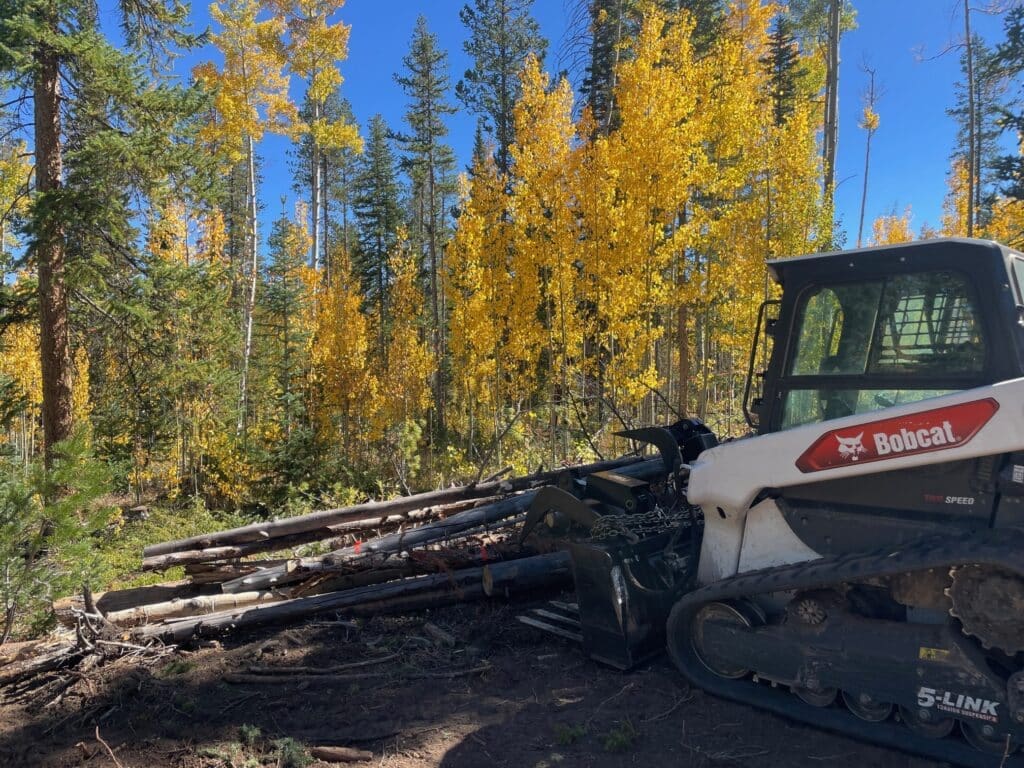
Skid Steer
Skid steer tractors equipped mulching heads are used primarily for mulching material up to 8″. Skid steers are used for small residential applications all the way up to large government forestry applications where the operator needs to work with a tighter window. Skid steer mulching heads are an effective way to clean up slash, brush, and debris after tree removal on small residential jobs but can also be used as an effective tool for forestry thinning projects where landowners are trying to open up the canopy of the forest floor.
Excavator
Excavator mulching heads are great for precision work when mulching trees. The operator can either come “top down” on a tree or can be very precise with the location of the mulching head. Large excavators with mulching heads are very efficient in their mulching capabilities and can process large amounts of product quickly. Large excavator mulchers are specifically useful in burn area cleanups after wildfires. Mulching the burned trees is a great way to beautify a property after the remains of a wildfire.
Tracked Machine
Tracked mulching machines like the PrimeTech PT175, PT300, or the Prinoth Raptor 300 are steel tracked machines made specifically for forestry mulching on large projects for private landowners, municipalities, or government agencies. These machines can process whole trees much quicker than a skid steer can because of the larger amount of horsepower and GPM (gallons per minute) of hydraulic flow to the mulching heads.
Bear Claw Land Services owns and operates state-of-the-art forestry mulching machines and equipment on the market and we use each of the different mulchers outlined above for different types of projects depending on the application needed by our clients.

Who Can Benefit From Forestry Mulching?
Forestry mulching can benefit a variety of individuals, organizations, and industries. Here are some examples:
- Landowners: Landowners who want to clear their property for agricultural, recreational, or building purposes can benefit from forestry mulching. It is an effective method for clearing vegetation and small trees without damaging the soil or environment. The resulting mulch can also be used to enrich the soil, saving the landowner money on fertilizer and other soil amendments.
- Homeowners: Homeowners can benefit from forestry mulching by creating defensible space around their homes to reduce the risk of wildfires. It can also be used to clear land for landscaping or other projects.
- Government Agencies: Government agencies responsible for managing public lands can benefit from forestry mulching as a tool for wildfire mitigation, habitat restoration, and vegetation management. It is a sustainable method that minimizes damage to the environment and promotes healthy forest ecosystems.
- Developers: Developers can benefit from forestry mulching by clearing land for construction projects while minimizing the impact on the environment. It is a cost-effective method that reduces the need for heavy equipment and can save developers money on disposal costs.
- Farmers and Ranchers: Farmers and ranchers can benefit from forestry mulching by clearing land for pasture or crop production. The resulting mulch can be used to improve soil health, reducing the need for synthetic fertilizers.
- Environmental Organizations: Environmental organizations can benefit from forestry mulching as a tool for habitat restoration, invasive species management, and erosion control. It is a sustainable method that promotes healthy ecosystems and minimizes damage to the environment.
How Much Does Forestry Mulching Cost?
The cost of forestry mulching per acre can vary depending on a variety of factors, including the size of the area to be cleared, the density of vegetation, the terrain, and the accessibility of the site. In general, the cost of forestry mulching per acre can range from $1,000 to $7,000 or more, depending on these factors.
For smaller areas, such as residential properties or small farms, the cost may be on the lower end of this range, around $1,000 to $3,500 per acre. For larger areas, such as commercial or government land, the cost may be on the higher end of the range, around $3,000 to $7,500 per acre or more.
It is important to note that while forestry mulching can be a cost-effective method for clearing land compared to other methods such as traditional land clearing, the cost can still be significant. Factors that can impact the cost include the size and complexity of the land clearing project, the equipment needed, and the experience and expertise of the contractor.

Other Factors That Alter Cost Of Forestry Mulching
-Region of project
-Type of material being mulched
-Steepness of land
-How rocky the land is
-How dense the vegetation is
It is recommended to get multiple quotes from different contractors to compare costs and ensure you are getting a fair price for the services provided. It is also important to choose a contractor who is experienced, licensed, and insured to ensure the job is done safely and efficiently.
Bear Claw Land services is experienced, licensed, insured, and committed to delivering 5 star service. If you’d like a more comprehensive free quote for your project, don’t hesitate to contact us!
Forestry Mulching Conclusion
Forestry mulching is an effective and environmentally friendly method of land clearing that offers many benefits. From soil improvement to habitat preservation, the process provides a sustainable solution for clearing land. With careful planning and execution, forestry mulching can help improve the health and vitality of natural habitats while creating a clean and functional space for future use.

